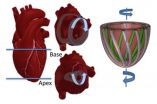(Press-News.org) A radiotherapy regime involving higher doses of radiation is a better option than having lower doses for men with localised prostate cancer, the 10-year results of the largest trial of its kind have shown.
Having 37 rounds, or fractions, of radiotherapy at 74 Gray (Gy) – compared with 32 fractions at 64 Gy – controlled the disease more effectively and reduced the chance that men would need follow-up hormone-deprivation therapy, which can have long-term side-effects.
The findings, published in The Lancet Oncology today (Wednesday), come from the major RT01 phase III trial. The trial was led by Professor Dearnaley at The Institute of Cancer Research, London, and The Royal Marsden NHS Foundation Trust, and was funded and conducted by the Medical Research Council Clinical Trials Unit at UCL. The study also involved several leading clinical research centres in the UK, New Zealand and Australia.
The study also demonstrated the overall effectiveness of radiotherapy for men with localised disease. Almost three quarters of men treated with either the more or less intensive radiotherapy regimes were still alive after 10 years.
Set up in 1998, the trial split 843 men with localised prostate cancer into two groups to compare the two doses of radiotherapy. Some 421 men had the less and 422 the more intensive treatment regimes. Both groups also had standard hormone-deprivation treatment alongside their radiotherapy.
The five-year results of the trial have previously shown the benefits of dose-escalated radiotherapy, and played an influential role in changing NICE guidance to recommend it in prostate cancer. Dose escalation is now the norm for localised prostate cancer in the UK.
The new 10-year results further strengthen the evidence for choosing dose-escalation radiotherapy, as well as showing the long-term benefits of the treatment.
After 10 years, 55 per cent of men on the 37-fraction regime, compared with 43 per cent of men on the 32-fraction regime, had survived without their disease progressing into a more hazardous form, as measured by the standard prostate-specific antigen (PSA) test. In each half of the study, 71 per cent of men were alive after 10 years and only 11 per cent had died from prostate cancer.
Men who received the higher dose were more likely to have side-effects associated with radiotherapy, but few men had severe side-effects. Receiving the higher dose reduced the need for follow-up hormone treatment, which also carries a risk of side-effects.
The trial did not show that men given dose-escalated radiotherapy live longer, but both groups of men lived much longer than expected. Almost three quarters of all the men in the study were still alive after 10 years, and of the 236 men who had died since treatment, only 91 had died of prostate cancer.
Study leader Professor David Dearnaley, Professor of Uro-Oncology at The Institute of Cancer Research, London, and Honorary Consultant at the Royal Marsden NHS Foundation Trust, said:
"Our study has proved that treating men with localised prostate cancer using higher doses of radiotherapy is more effective than a less intensive regime. The dose-escalated regime is safe in the long term, and reduces the chances that a cancer will return and men will require further hormone-deprivation treatment. The side-effects of hormone treatment do need to be balanced against those of the extra radiotherapy doses, but overall our study has shown men are better off after having the escalated regime, as is now the norm in the UK.
"Another key finding to come out of our study is that radiotherapy in general is both a safe and an effective treatment for localised prostate cancer. Almost three quarters of men treated with either the more or less intensive radiotherapy regimes are still alive after 10 years, and of the men who have died, less than half actually died from prostate cancer.
"Further refinements in radiotherapy techniques since our trial began have made treatment even safer and are very important as men with localised prostate cancer have such favourable long-term survival prospects."
Matthew Sydes, Senior Scientist and Statistician at the MRC Clinical Trials Unit at UCL, said:
"The RT01 trial has already changed how men with localised prostate cancer are treated. The current NICE guidelines recommend the use of the higher dose of radiotherapy, based on the five-year results of RT01. The trial also helped to develop guidelines on how to limit the radiation that organs near the tumour receive, and helped hospitals across the UK to introduce quality-assured conformal radiotherapy. It is now contributing to biological studies to help better understand the disease and the side-effects of radiotherapy."
INFORMATION:
Notes to Editors
For more information contact the ICR press office on 020 7153 5380 / henry.french@icr.ac.uk. For enquiries out of hours, please call 07976 751984.
Advance access to this The Lancet Oncology article is provided for media use only; if you wish to link to this study online, please use the following URL, which will go live when the embargo lifts: http://www.thelancet.com/journals/lanonc/article/PIIS1470-2045(14)70040-3/abstract
The Institute of Cancer Research, London, is one of the world's most influential cancer research institutes.
Scientists and clinicians at The Institute of Cancer Research (ICR) are working every day to make a real impact on cancer patients' lives. Through its unique partnership with The Royal Marsden Hospital and 'bench-to-bedside' approach, the ICR is able to create and deliver results in a way that other institutions cannot. Together the two organisations are rated in the top four cancer centres globally.
The ICR has an outstanding record of achievement dating back more than 100 years. It provided the first convincing evidence that DNA damage is the basic cause of cancer, laying the foundation for the now universally accepted idea that cancer is a genetic disease. Today it leads the world at isolating cancer-related genes and discovering new targeted drugs for personalised cancer treatment.
As a college of the University of London, the ICR provides postgraduate higher education of international distinction. It has charitable status and relies on support from partner organisations, charities and the general public.
The ICR's mission is to make the discoveries that defeat cancer. For more information visit http://www.icr.ac.uk
The Royal Marsden NHS Foundation Trust
The Royal Marsden opened its doors in 1851 as the world's first hospital dedicated to cancer diagnosis, treatment, research and education.
Today, together with its academic partner, The Institute of Cancer Research (ICR), it is the largest and most comprehensive cancer centre in Europe treating over 50,000 NHS and private patients every year. It is a centre of excellence with an international reputation for groundbreaking research and pioneering the very latest in cancer treatments and technologies.
The Royal Marsden, with the ICR, is the only National Institute for Health Research Biomedical Research Centre for Cancer. First awarded the status in 2006, it was re-awarded in 2011. A total of £62 million is being provided over five years, to support pioneering research work, and is being shared out over eight different cancer themes.
The Royal Marsden also provides community services in the London boroughs of Sutton and Merton and in June 2010, along with the ICR, the Trust launched a new academic partnership with Mount Vernon Cancer Centre in Middlesex.
Since 2004, the hospital's charity, The Royal Marsden Cancer Charity, has helped raise over £100 million to build theatres, diagnostic centres, and drug development units. Prince William became President of The Royal Marsden in 2007, following a long royal connection with the hospital. For more information, visit http://www.royalmarsden.nhs.uk
The Medical Research Council
Over the past century, the Medical Research Council has been at the forefront of scientific discovery to improve human health. Founded in 1913 to tackle tuberculosis, the MRC now invests taxpayers' money in some of the best medical research in the world across every area of health. Twenty-nine MRC-funded researchers have won Nobel prizes in a wide range of disciplines, and MRC scientists have been behind such diverse discoveries as vitamins, the structure of DNA and the link between smoking and cancer, as well as achievements such as pioneering the use of randomised controlled trials, the invention of MRI scanning, and the development of a group of antibodies used in the making of some of the most successful drugs ever developed.
Today, MRC-funded scientists tackle some of the greatest health problems facing humanity in the 21st century, from the rising tide of chronic diseases associated with ageing to the threats posed by rapidly mutating micro-organisms. http://www.mrc.ac.uk
The MRC Centenary Timeline chronicles 100 years of life-changing discoveries and shows how our research has had a lasting influence on healthcare and wellbeing in the UK and globally, right up to the present day. http://www.centenary.mrc.ac.uk/
More intensive radiotherapy is better than less for localized prostate cancer
2014-02-26
ELSE PRESS RELEASES FROM THIS DATE:
Skin cancer risk may have driven evolution of black skin
2014-02-26
Early humans may have evolved black skin to protect against a very high risk of dying from ultraviolet light (UV)-induced skin cancer, a new analysis concludes.
Skin cancer has usually been rejected as the most likely selective pressure for the development of black skin because of a belief that it is only rarely fatal at ages young enough to affect reproduction.
But a new paper, published in Proceedings of the Royal Society B, cites evidence that black people with albinism from parts of Africa with the highest UV radiation exposure, and where humans first evolved, almost ...
Smithsonian scientists solve 'sudden death at sea' mystery
2014-02-26
Mass strandings of whales have puzzled people since Aristotle. Modern-day strandings can be investigated and their causes, often human-related, identified. Events that happened millions of years ago, however, are far harder to analyze—frequently leaving their cause a mystery. A team of Smithsonian and Chilean scientists examined a large fossil site of ancient marine mammal skeletons in the Atacama Desert of Northern Chile—the first definitive example of repeated mass strandings of marine mammals in the fossil record. The site reflected four distinct strandings over time, ...
Brain cell activity regulates Alzheimer's protein
2014-02-26
Increased brain cell activity boosts brain fluid levels of a protein linked to Alzheimer's disease, according to new research from scientists at Washington University School of Medicine in St. Louis.
Tau protein is the main component of neurofibrillary tangles, one of the hallmarks of Alzheimer's disease. It has been linked to other neurodegenerative disorders, including frontotemporal dementia, supranuclear palsy and corticobasal degeneration.
"Healthy brain cells normally release tau into the cerebrospinal fluid and the interstitial fluid that surrounds them, but ...
SMA unveils how small cosmic seeds grow into big stars
2014-02-26
New images from the Smithsonian's Submillimeter Array (SMA) telescope provide the most detailed view yet of stellar nurseries within the Snake nebula. These images offer new insights into how cosmic seeds can grow into massive stars.
Stretching across almost 100 light-years of space, the Snake nebula is located about 11,700 light-years from Earth in the direction of the constellation Ophiuchus. In images from NASA's Spitzer Space Telescope it appears as a sinuous, dark tendril against the starry background. It was targeted because it shows the potential to form many massive ...
Follow-up care for older breast cancer survivors needs to be all-encompassing
2014-02-26
Older women who have overcome breast cancer are likely to struggle with heart disease, osteoporosis and hypertension further on in their lives. Whether these conditions occur or not is influenced by the treatment that patients received to fight cancer, their overall weight and their age. Breast cancer survivors therefore should watch their weight and get regular exercise so that they can enjoy a high quality of life. These findings, by lead author Nadia Obi of the University Medical Center Hamburg-Eppendorf, who collaborated with the group of Prof. Chang-Claude from the ...
New research indicates causal link between vitamin D, serotonin synthesis and autism
2014-02-26
February 26, 2014 - Oakland, CA – A new study by Rhonda Patrick, PhD and Bruce Ames, PhD of Children's Hospital Oakland Research Institute (CHORI) demonstrates the impact that Vitamin D may have on social behavior associated with Autism Spectrum Disorder (ASD). Dr. Patrick and Dr. Ames show that serotonin, oxytocin, and vasopressin, three brain hormones that affect social behavior, are all activated by vitamin D hormone. Autism, which is characterized by abnormal social behavior, has previously been linked to low levels of serotonin in the brain and to low vitamin D levels, ...
Beaumont study: Gamma Knife helps patients with painful facial nerve disorder
2014-02-26
Research by Beaumont Health System radiation oncologists and neurosurgeons found that symptoms of trigeminal neuralgia, or TN, a nerve disorder causing severe facial pain, were reduced in those treated with Gamma Knife stereotactic radiosurgery. The results were published in the February issue of the journal Clinical Neurology and Neurosurgery.
TN is a disorder of the trigeminal nerve, which is responsible for feeling in the face. In most cases, the facial pain is caused by a blood vessel pressing on the nerve. It is believed that TN is caused by deterioration of the ...
Reproductive coercion, intimate partner violence prevalent
2014-02-26
Enough women experience reproductive coercion – male behavior to control contraception and pregnancy outcomes – that a research team now recommends health care providers address the subjects with their patients and tailor family planning discussions and recommendations accordingly.
Researchers from Women & Infants Hospital of Rhode Island were part of a team that published "Reproductive coercion and co-occurring intimate partner violence in obstetrics and gynecology patients" in a recent issue of the American Journal of Obstetrics and Gynecology.
"Reproductive coercion, ...
Artificial muscles that do the twist
2014-02-26
In the heart, as in the movies, 3D action beats the 2D experience hands down.
In 3D, healthy hearts do their own version of the twist. Rather than a simple pumping action, they circulate blood as if they were wringing a towel. The bottom of the heart twists as it contracts in a counterclockwise direction while the top twists clockwise. Scientists call this the left ventricular twist—and it can be used as an indicator of heart health.
The heart is not alone. The human body is replete with examples of soft muscular systems that bend, twist, extend, and flex in complex ...
Superabsorbing design may lower manufacturing cost of thin film solar cells
2014-02-26
Researchers from North Carolina State University have developed a "superabsorbing" design that may significantly improve the light absorption efficiency of thin film solar cells and drive down manufacturing costs.
The superabsorbing design could decrease the thickness of the semiconductor materials used in thin film solar cells by more than one order of magnitude without compromising the capability of solar light absorption.
"State-of-the-art thin film solar cells require an amorphous silicon layer that is about 100 nanometers (nm) thick to capture the majority of the ...




